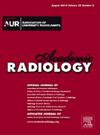Quantitative and Visual Benefits of Data-Driven Motion Correction on Oncologic PET/CT: A Prospective Cross-sectional Study
IF 3.8
2区 医学
Q1 RADIOLOGY, NUCLEAR MEDICINE & MEDICAL IMAGING
引用次数: 0
Abstract
Rationale and Objective
Conventional positron emission tomography (PET) respiratory gating utilizes a fraction of acquired PET counts (i.e., optimal gate [OG]), whereas elastic motion correction with deblurring (EMCD) utilizes all PET counts to reconstruct motion-corrected images without increasing image noise. Our aim was to assess the quantitative and visual impacts of EMCD-based motion correction on FDG-PET and DOTATATE-PET images relative to OG and ungated (UG) images.
Materials and Methods
This prospective, single-center study enrolled adults undergoing FDG or DOTATATE oncologic PET/CT between June 2020 and October 2022. Subjects underwent a standard-of-care (SOC) PET acquisition while wearing a respiratory gating belt. UG, belt-gating-derived optimal gate (BG-OG), EMCD utilizing belt gating (BG-EMCD), and EMCD utilizing data-driven gating (DDG-EMCD) images were reconstructed. Tracer-avid lesions in the lower chest or upper abdomen were segmented. Quantitative metrics were extracted. Two independent, blinded readers assessed image quality via a 4-point scale and counted lesions on each reconstruction. Differences between reconstructions were assessed via the Wilcoxon signed-rank test (alpha, 0.05).
Results
This study enrolled 78 subjects; 36 subjects (mean age, 64.8 years; 20 males) with 136 tracer-avid lesions were analyzed. Data provided are medians across all tracers. Lesion SUV-max was significantly higher (P < 0.001) on motion-corrected images (BG-OG: 10.77, BG-EMCD: 10.75, DDG-EMCD: 10.74) than UG images (9.00). Lesion contrast-to-noise ratios (CNRs) were significantly lower (P < 0.001) for BG-OG (6.31) and UG images (7.89) than BG-EMCD (9.14) and DDG-EMCD (8.89) images. FDG and DOTATATE subgroup analyses produced similar results. Among motion-corrected images, both readers preferred EMCD-based images to BG-OG images for all tracers (P < 0.001) and both subgroups. EMCD-based images occasionally demonstrated more tracer-avid lesions than BG-OG or UG images.
Conclusion
EMCD-based motion correction beneficially impacts lesion quantitation (including higher SUVs and CNRs) and overall image quality.
Clinical Impact
When employed on capable scanners, EMCD can improve the quality of oncologic PET imaging.
求助全文
约1分钟内获得全文
求助全文
来源期刊

Academic Radiology
医学-核医学
CiteScore
7.60
自引率
10.40%
发文量
432
审稿时长
18 days
期刊介绍:
Academic Radiology publishes original reports of clinical and laboratory investigations in diagnostic imaging, the diagnostic use of radioactive isotopes, computed tomography, positron emission tomography, magnetic resonance imaging, ultrasound, digital subtraction angiography, image-guided interventions and related techniques. It also includes brief technical reports describing original observations, techniques, and instrumental developments; state-of-the-art reports on clinical issues, new technology and other topics of current medical importance; meta-analyses; scientific studies and opinions on radiologic education; and letters to the Editor.
 求助内容:
求助内容: 应助结果提醒方式:
应助结果提醒方式:


